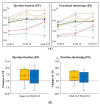A Pilot Clinical Study of Liquid Ubiquinol Supplementation on Cardiac Function in Pediatric Dilated Cardiomyopathy
- PMID: 30405022
- PMCID: PMC6266971
- DOI: 10.3390/nu10111697
A Pilot Clinical Study of Liquid Ubiquinol Supplementation on Cardiac Function in Pediatric Dilated Cardiomyopathy
Abstract
Background: Pediatric dilated cardiomyopathy (PDCM) is a life-threatening type of cardiac muscle dysfunction in children. Ubiquinone is a lipid-soluble nutrient that participates in energy synthesis. Recently, a novel hydrophilic ubiquinol supplement was developed. The purpose of this study was to assess the effect of liquid ubiquinol supplementation (10 mg/kg body weight/day) on cardiac function in children with PDCM.
Methods: Ten children diagnosed with PDCM were recruited to this study and administered with liquid ubiquinol for 24 weeks. The cardiac function was measured by echocardiography. The New York Heart Association (NYHA) functional classification was used to assess symptoms of heart failure. Plasma coenzyme Q10 levels were measured during the study.
Results: Ejection fraction (EF) and fractional shortening (FS) were significantly higher than the baseline values until week 16 of supplementation. Subjects who had higher plasma coenzyme Q10 concentration had significantly better EF and FS values. In addition, 30% of the subjects showed improvement in the NYHA classification after 24 weeks of supplementation.
Conclusion: Liquid ubiquinol supplementation is associated with an increase the level of coenzyme Q10 to complementary improve cardiac function (particularly EF and FS) and ameliorate the symptoms of heart failure in children with PDCM.
Keywords: coenzyme Q10; dietary supplementation; heart failure; liquid ubiquinol; pediatric dilated cardiomyopathy; pediatric nutrition.
Conflict of interest statement
The authors have no conflict of interest.
Figures




References
-
- Lipshultz S.E., Cochran T.R., Briston D.A., Brown S.R., Sambatakos P.J., Miller T.L., Carrillo A.A., Corcia L., Sanchez J.E., Diamond M.B., et al. Pediatric cardiomyopathies: Causes, epidemiology, clinical course, preventive strategies and therapies. Future Cardiol. 2013;9:817–848. doi: 10.2217/fca.13.66. - DOI - PMC - PubMed
Publication types
MeSH terms
Substances
Grants and funding
LinkOut - more resources
Full Text Sources
Medical

